Originally posted on December 4, 2023 @ 4:21 am
Are you in a pinch and need to substitute ginger in your favorite recipes? Don’t worry, we’ve got you covered. Ginger is a versatile ingredient that adds a unique flavor to dishes, but sometimes it’s not readily available in your pantry. Luckily, there are several alternatives you can use to replace ginger and still achieve delicious results. Let’s explore some of the best substitutes for ginger that you can easily find in your kitchen.
Table of Contents
Key Takeaways:
- Ground ginger, crystallized ginger, galangal, and various spices like allspice, turmeric, cardamom, cinnamon, nutmeg, and mace can all be used as substitutes for ginger.
- Ground ginger is a convenient substitute and can be used in a 1:1 ratio with fresh ginger.
- Crystallized ginger works well in sweet dishes and can be directly substituted for fresh ginger in baking.
- Galangal is a close relative of ginger and offers a similar flavor profile in recipes.
- Spices like allspice, turmeric, cardamom, cinnamon, nutmeg, and mace can add a similar flavor to dishes that call for ginger.
Ground Ginger – A Convenient Substitute
When you’re in need of a substitute for fresh ginger, look no further than ground ginger. This convenient alternative provides the same distinctive flavor in a different form, making it an ideal replacement for recipes that call for fresh ginger. Ground ginger can be used in a 1:1 ratio, but it’s important to note that it is more potent than fresh ginger. Using too much ground ginger can result in a dish with a stronger heat and earthiness.
To ensure the right balance of flavors, use ¼ to ½ teaspoon of ground ginger for every 1 tablespoon of fresh ginger required in your recipe. Experiment with smaller amounts and adjust to taste, keeping in mind that a little goes a long way. Ground ginger pairs well with a variety of dishes, from stir-fries to desserts, and can add a warm and aromatic touch to your culinary creations.
“Ground ginger is the easiest substitute for fresh ginger, providing the same flavor in a different form.”
Ginger Flavor Alternatives
If you’re looking to explore alternative flavors while still capturing the essence of ginger, there are a few options to consider. You can experiment with spices such as allspice, turmeric, cardamom, cinnamon, nutmeg, and mace. While these spices may not taste exactly like ginger, they can provide a similar flavor profile to enhance your recipes.
Each of these spices has its own unique characteristics that can lend a distinct taste to your dishes. For example, allspice adds a sweet and spicy flavor, while cinnamon brings warmth and sweetness. Nutmeg offers a woody and slightly sweet taste, and mace has a milder flavor compared to nutmeg. Turmeric, known for its vibrant yellow color, brings a slightly bitter taste to the table. Experiment with these spices to create a signature flavor combination that suits your preferences.
Table: Ground Ginger Substitutes
| Substitute | Conversion Ratio | Flavor Profile |
|---|---|---|
| Ground Ginger | 1:1 | Similar heat and earthiness |
| Allspice | 1 tablespoon per 1 tablespoon of ginger | Sweet and spicy |
| Turmeric | 1 teaspoon per 1 tablespoon of ginger | Bitter and earthy |
| Cardamom | 1 teaspoon per 1 tablespoon of ginger | Sweet and savory |
| Cinnamon | 1 teaspoon per 1 tablespoon of ginger | Warm and sweet |
| Nutmeg | 1 teaspoon per 1 tablespoon of ginger | Woody and sweet |
| Mace | 1 teaspoon per 1 tablespoon of ginger | Slightly milder than nutmeg |
Explore the world of ginger substitutes to add a distinctive flavor to your dishes, even when fresh ginger is not available. Whether you opt for ground ginger or experiment with other spices, these alternatives can help you achieve the desired taste and aroma in your culinary creations. Enjoy the convenience and versatility of ginger flavor alternatives as you embark on your cooking adventures.
Crystallized Ginger – A Sweet Alternative
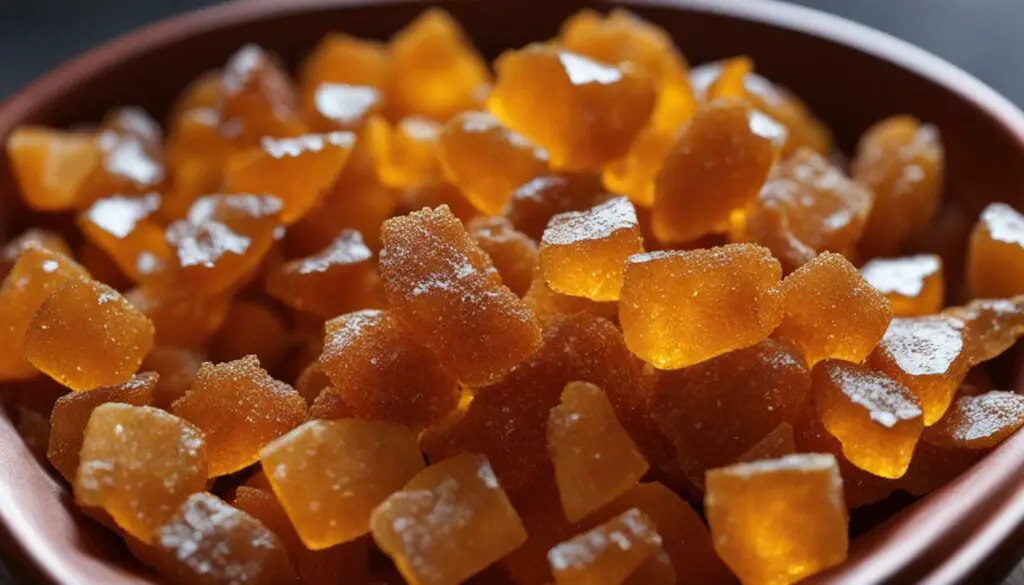
If you’re looking for a sweet alternative to ground ginger, crystallized ginger, also known as candied ginger, is a delicious option. Made by boiling fresh ginger in a mixture of sugar and water and then rolling it in sugar, crystallized ginger adds a touch of sweetness to your dishes while still providing that distinct ginger flavor. It can be used as a substitute for ground or fresh ginger in a variety of sweet recipes.
When using crystallized ginger in your baking, you can choose to keep the pieces larger for added texture and a more pronounced ginger flavor with each bite. Alternatively, you can finely chop the crystallized ginger to distribute the taste more evenly throughout the dish. When substituting crystallized ginger for fresh ginger, use approximately 3 tablespoons of finely chopped crystallized ginger to replace 1 tablespoon of fresh ginger.
Crystallized ginger is especially popular in baked goods like cookies, cakes, and breads. Its sweet and zesty flavor pairs well with the warmth of cinnamon and nutmeg, making it a great addition to holiday treats like gingerbread. It can also be used in glazes, sauces, chutneys, and even savory dishes like stir-fries and marinades to add a unique twist.
So, the next time you find yourself without ground or fresh ginger, reach for some crystallized ginger instead. Its sweet and flavorful profile will elevate your dishes and provide a delightful alternative.
Galangal – A Close Relative to Ginger
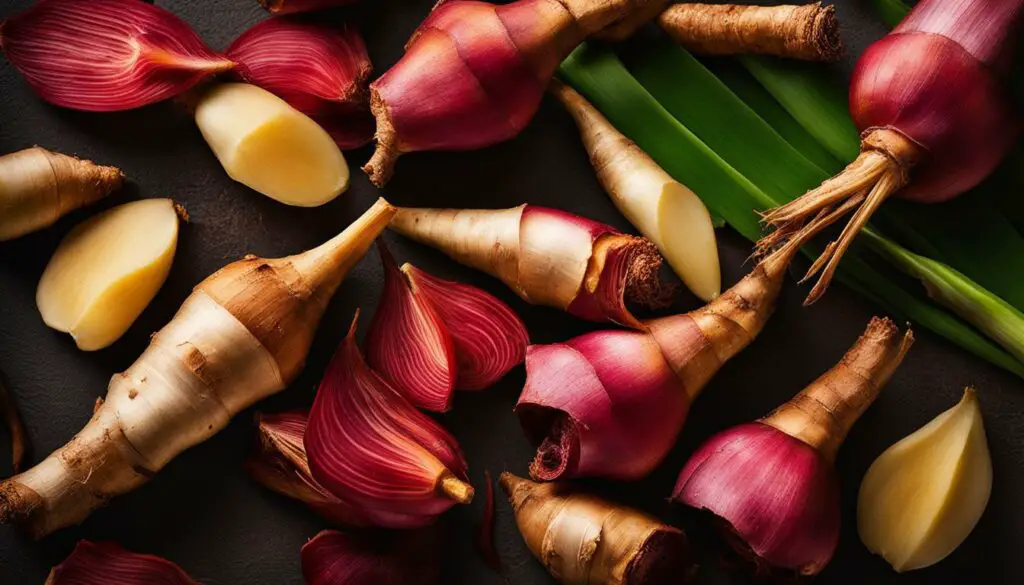
When it comes to finding a substitute for ginger in your recipes, look no further than galangal. This root spice is a close relative to ginger and can be used as a 1:1 replacement in your dishes. Both ginger and galangal belong to the rhizome family, meaning they have stems that spread underground and give off shoots that become new rootstalks. This similarity in structure gives galangal a similar flavor profile to ginger, making it an excellent substitute.
While galangal shares many characteristics with ginger, it does have its own unique taste. Galangal has piney and citrusy notes that ginger does not possess, adding an intriguing twist to your recipes. This flavor profile makes galangal especially well-suited for dishes that incorporate citrus or lemongrass alongside ginger. By using galangal as a substitute, you can maintain the essence of ginger in your recipes while introducing a hint of pine and citrus.
Whether you’re preparing a savory curry or a zesty stir-fry, galangal can step in as a reliable substitute for ginger. Its similar flavor and rhizome structure make it an ideal choice when ginger is not available. So the next time you’re in need of ginger but find yourself without it, give galangal a try and discover a new dimension of flavor for your dishes.
Table: Galangal vs Ginger
| Feature | Galangal | Ginger |
|---|---|---|
| Flavor | Piney and citrusy | Spicy, pungent, and slightly sweet |
| Use | Commonly used in Thai and Southeast Asian cuisine | Widely used in various cuisines worldwide |
| Appearance | Lighter in color with a smoother skin | Darker brown with a rougher skin |
Spice Substitutes – Allspice, Turmeric, Cardamom, Cinnamon, Nutmeg, and Mace
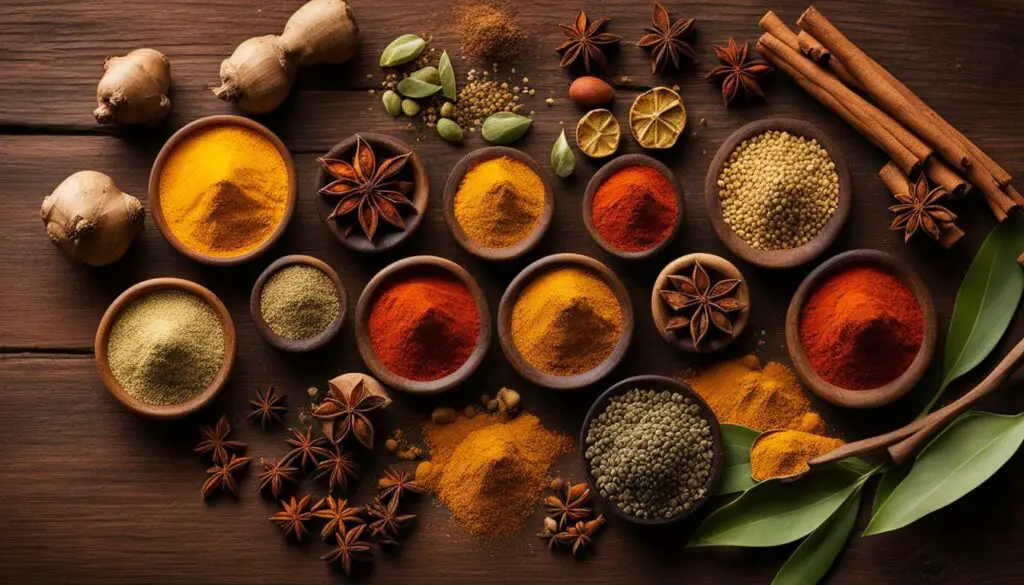
If you don’t have ginger on hand, you can use spices like allspice, turmeric, cardamom, cinnamon, nutmeg, and mace as substitutes. While these spices don’t taste exactly like ginger, they can add a similar flavor to your recipes. In quick breads and other baked goods that call for ground ginger, you can substitute the same amount of any of these spices or a mixture of them for a unique flavor profile. Each spice has its own characteristics and can enhance different types of dishes.
Here is a table summarizing the flavor profiles and recommended uses for each spice:
| Spice | Flavor Profile | Recommended Uses |
|---|---|---|
| Allspice | Warm, sweet, and slightly peppery | Pies, cakes, cookies, and other baked goods |
| Turmeric | Bitter and earthy | Curry dishes, soups, and stews |
| Cardamom | Sweet, spicy, and slightly floral | Chai tea, desserts, and savory dishes |
| Cinnamon | Warm, sweet, and slightly spicy | Baked goods, hot beverages, and savory dishes |
| Nutmeg | Woody, warm, and slightly sweet | Eggnog, custards, and savory dishes |
| Mace | Milder version of nutmeg, slightly citrusy | Baked goods, soups, and sauces |
Experiment with different combinations of these spices to find the perfect substitute for ginger in your recipes. Keep in mind that the flavor profile may vary slightly, so adjustments may be needed to achieve the desired taste. Whether you’re baking a batch of cookies or preparing a savory dish, these spice substitutes can add a unique twist to your culinary creations.
Fresh Ginger – Freezing for Future Use
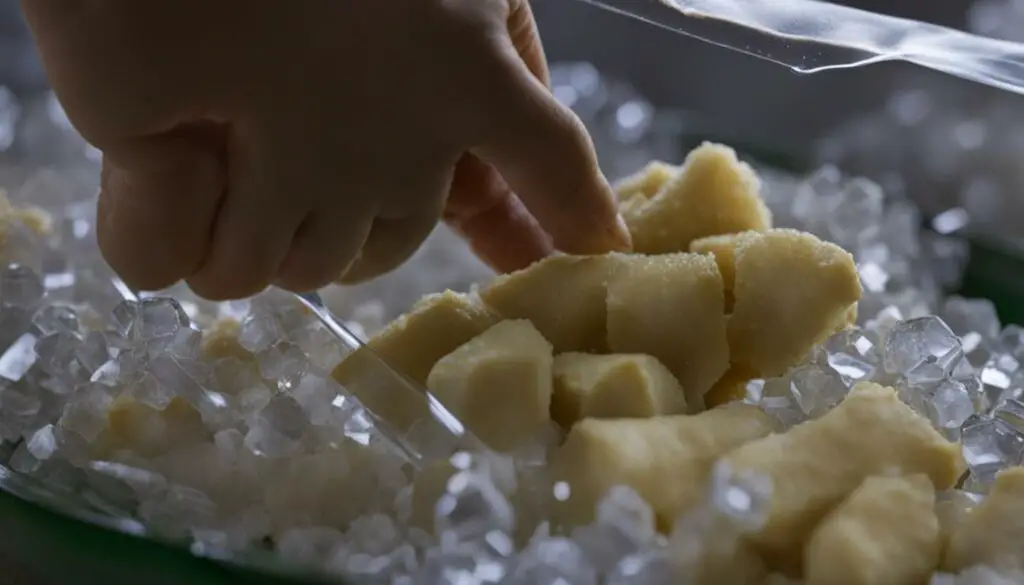
To ensure that you always have ginger on hand, you can freeze fresh ginger for future use. Freezing ginger is a simple and convenient method that allows you to have this versatile ingredient ready whenever you need it in your recipes. Here’s how you can freeze ginger:
- Start by selecting fresh ginger root that is firm, plump, and free from any mold or blemishes.
- Wash the ginger root thoroughly under cold water to remove any dirt or debris.
- Peel the ginger using a vegetable peeler or the edge of a spoon.
- Once peeled, you can choose to freeze the ginger whole or cut it into smaller pieces. If you prefer to have smaller portions, slice or grate the ginger into convenient-sized portions.
- Place the ginger pieces in an airtight bag or container, ensuring that there is minimal air inside. Label the container with the date of freezing.
- Store the ginger in the freezer, where it can last for up to 6 months without losing its flavor or aroma.
When you need to use frozen ginger, simply remove it from the freezer and thaw it at room temperature. You can grate or slice the ginger as required for your recipe. Frozen ginger can be used in the same quantities as fresh ginger, allowing you to enjoy its unique flavor and health benefits all year round.
Frozen Ginger Storage Tips
Here are some additional tips to ensure the optimum storage of your frozen ginger:
- Always use an airtight bag or container to prevent freezer burn and maintain the ginger’s freshness.
- Consider portioning the ginger into smaller amounts, so you only thaw what you need, reducing waste.
- If you frequently use ginger in your cooking, it may be helpful to label and organize your frozen ginger by date or portion size for easy retrieval.
- Avoid refreezing ginger that has been thawed, as the texture and flavor may be compromised.
With the convenience of frozen ginger, you can explore a wide range of recipes without worrying about running out of this essential ingredient. So, stock up on fresh ginger, freeze it, and enjoy its vibrant flavor whenever inspiration strikes!
Ginger Paste or Minced Ginger – Convenient Alternatives

If you don’t have fresh ginger on hand, don’t worry! There are convenient alternatives available in the form of ginger paste or minced ginger. These pre-packaged substitutes offer the same spicy kick as fresh ginger, as they are either pressed or finely chopped to release the essential oils. They can be used in a 1:1 exchange for fresh ginger in your recipes.
Ginger paste and minced ginger are excellent options when you’re short on time or simply prefer the convenience of pre-packaged ingredients. They provide the same distinct flavor and aroma that fresh ginger brings to your dishes. However, it’s essential to be mindful of any additional ingredients like salt and sugar that may be present in some brands.
Using ginger paste or minced ginger is an excellent way to add the signature zing of ginger to your recipes without the hassle of peeling, grating, or chopping fresh ginger. They are a time-saving option for busy home cooks or anyone looking for a convenient and reliable substitute for fresh ginger.
With ginger paste or minced ginger, you can continue to enjoy the unique flavors that ginger adds to your favorite dishes. Whether it’s a stir-fry, curry, marinade, or sauce, these alternatives provide a quick and easy way to incorporate the distinctive taste of ginger into your cooking.
Now that you know about these convenient alternatives, you can confidently replace fresh ginger in your recipes with ginger paste or minced ginger. Experiment with different brands and find the one that suits your taste preferences. Enjoy the rich flavor and aromatic goodness of ginger without the need for fresh ginger in your pantry!
Dried Ginger – Ground Ginger for Flavor
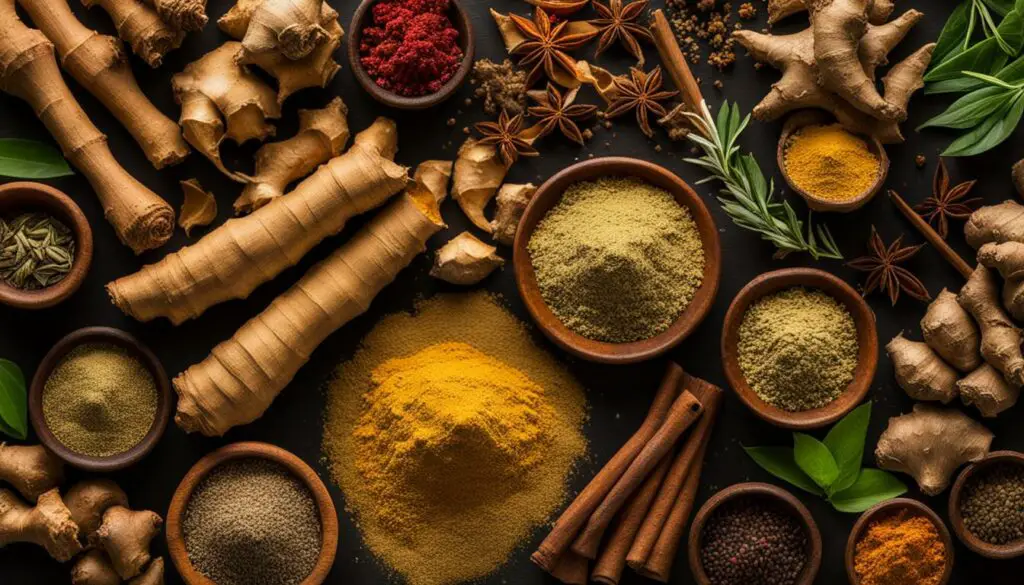
Dried ginger, also known as ground ginger, is a convenient substitute for fresh ginger in recipes. While it has a slightly milder taste, it still maintains a distinct ginger flavor. Ground ginger is a concentrated form, so you only need a small amount to replace fresh ginger. Using dried ginger as a substitute allows you to enjoy the flavor of ginger even when you don’t have fresh ginger on hand.
To use dried ginger as a substitute, simply use ¼ teaspoon of ground ginger for every 1 tablespoon of fresh ginger called for in a recipe. Adjust the amount as needed to achieve the desired flavor. Keep in mind that dried ginger may not have the same texture as fresh ginger, so it’s best suited for recipes where texture is not a crucial factor.
Adding a pinch of dried ginger to your dishes can infuse them with a warm and spicy flavor, enhancing the overall taste profile. Whether you’re making savory dishes like stir-fries or sweet treats like gingerbread, dried ginger can be a versatile substitute that delivers the essence of ginger.
Try experimenting with dried ginger in your favorite recipes to discover new flavors and combinations. The concentrated flavor of dried ginger can add depth and complexity to your dishes, making them more exciting and satisfying. Keep a jar of ground ginger in your pantry for those times when fresh ginger is not available, and enjoy the distinct taste of ginger in your cooking.
Crystallized Ginger – A Sweet Treat and Stomach Settler

Crystallized ginger, also known as candied ginger, is not only a substitute for ground or fresh ginger but also a flavorful treat. It is made by cooking fresh ginger in sugar water and then rolling it in sugar. While it has a sweeter taste compared to fresh ginger, it can still work well in certain baked dishes. You will need to use more crystallized ginger than the recipe calls for due to its less pungent taste.
Aside from its delightful sweetness, crystallized ginger also offers some health benefits. It is known for its ability to settle an upset stomach and relieve nausea. The natural compounds in ginger have been found to have anti-inflammatory and antioxidant effects as well. So, when using crystallized ginger as a substitute, you not only enhance the flavor of your dishes but also potentially improve your digestion and overall well-being.
“Crystallized ginger adds a lovely touch of sweetness and a subtle ginger flavor to my homemade gingerbread cookies. It’s the perfect substitute if I don’t have fresh ginger on hand.” – Anna, Home Baker
Crystallized Ginger in Sweet and Savory Dishes
Crystallized ginger can be used in a variety of recipes, both sweet and savory. Its unique flavor profile makes it a versatile ingredient that can add a touch of sweetness and a hint of ginger to your dishes. In sweet recipes like cookies, cakes, and muffins, finely chop or dice the crystallized ginger to distribute it evenly throughout the batter. In savory dishes like stir-fries or marinades, larger pieces of crystallized ginger can be used to provide bursts of flavor. Experiment with different recipes to explore the many possibilities of using crystallized ginger as a substitute.
| Ways to Use Crystallized Ginger | |
|---|---|
| Sweet Dishes | Savory Dishes |
|
|
The unique flavor and versatility of crystallized ginger make it a valuable substitute for fresh ginger in a range of dishes. Whether you’re craving something sweet or looking to add a twist to your savory creations, crystallized ginger can be the perfect ingredient to satisfy your taste buds. So the next time you find yourself without fresh ginger, reach for the crystallized version and enjoy its delightful flavor and potential health benefits.
Spices as Ginger Substitutes – Allspice, Cinnamon, Nutmeg, Mace
When it comes to replacing ginger in your recipes, spices can offer unique and flavorful alternatives. Allspice, cinnamon, nutmeg, and mace can provide a similar taste profile to ginger, adding depth and complexity to your dishes.
Allspice, with its sweet and spicy flavor, can be a versatile substitute for ginger. It adds warmth and richness to both sweet and savory recipes. Cinnamon, known for its warm and sweet taste, can also be used as a ginger substitute in baking and cooking. Its aromatic notes complement a wide range of flavors.
Nutmeg and mace, both derived from the same plant, offer a slightly milder alternative to ginger. Nutmeg has a woody and sweet taste while mace provides a delicate and slightly pepper-like flavor. These spices can be used in various dishes to provide a unique twist and enhance the overall flavor profile.
| Spice | Taste | Best Suited for |
|---|---|---|
| Allspice | Sweet and spicy | Baked goods, stews, marinades |
| Cinnamon | Warm and sweet | Baking, desserts, warm beverages |
| Nutmeg | Woody and sweet | Baked goods, creamy dishes |
| Mace | Delicate and slightly peppery | Meat dishes, soups, sauces |
Experiment with these spices to find the right balance in your recipes. You can use them in the same quantities as ginger or adjust according to your taste preferences. Their unique flavors will bring a new dimension to your dishes and allow you to create exciting and delicious meals without ginger.
Turmeric, Cardamom, and Ginseng – Flavorful Substitutes
Turmeric, cardamom, and ginseng are excellent substitutes for ginger in various recipes, particularly in Asian cuisine. These ingredients offer unique flavors that can enhance the taste profiles of your dishes. Let’s take a closer look at each substitute:
Turmeric
Turmeric has a vibrant yellow color and a distinct bitter taste. While it doesn’t provide the same spicy kick as ginger, it adds a complex flavor to dishes. Turmeric is commonly used in curries, soups, and stews, and it pairs well with other spices like cumin and coriander.
Cardamom
Cardamom is a versatile spice that offers a balanced combination of sweetness and savory flavors. It has a slightly citrusy and minty taste, making it an excellent substitute for ginger in both sweet and savory dishes. Cardamom is commonly used in Indian and Middle Eastern cuisines, especially in desserts and teas.
Ginseng
Ginseng is a root with a flavor profile similar to ginger. It has a slightly bitter and earthy taste, with a hint of sweetness. Ginseng is commonly used in traditional Asian medicine and cuisine. It can be used as a substitute for ginger in dishes like stir-fries, soups, and herbal teas.
Experiment with these flavorful substitutes to create unique and delicious dishes without ginger. Remember to adjust the quantities based on your personal taste preferences and the specific recipe you’re following. Enjoy exploring the world of Asian flavors with turmeric, cardamom, and ginseng!
Conclusion
If you ever find yourself without ginger in your pantry, fear not! There are plenty of alternatives to replace ginger in your recipes. From ground ginger to spices like allspice, cinnamon, nutmeg, and mace, as well as ginger paste, dried ginger, crystallized ginger, and even other roots like galangal and ginseng, the options are endless.
These substitutes can be used in a variety of sweet and savory dishes, allowing you to recreate the unique flavor profile that ginger provides. Whether you’re baking a cake, making a stir-fry, or preparing a curry, you can still enjoy delicious and ginger-free cooking.
Experiment with different substitutes to find your favorites and discover new flavor combinations. Don’t be afraid to get creative in the kitchen and explore the world of ginger replacements. With these alternatives at your disposal, you’ll never have to worry about missing out on the flavors that ginger brings to your dishes.
FAQ
Can I substitute ground ginger for fresh ginger?
Yes, ground ginger can be used as a 1:1 substitute for fresh ginger in most recipes. Just be aware that ground ginger is more potent, so adjust the amount accordingly.
What can I use as a substitute for fresh ginger in baking?
Crystallized ginger, also known as candied ginger, works well as a substitute for fresh ginger in sweet dishes. Use 3 tablespoons of finely chopped crystallized ginger to replace 1 tablespoon of fresh ginger.
What is galangal and can it be used as a substitute for ginger?
Galangal is a close relative to ginger and can be used as a 1:1 substitute in recipes. It has a similar overall flavor profile but with piney and citrusy notes that ginger does not have.
What spices can I use as substitutes for ginger?
Allspice, turmeric, cardamom, cinnamon, nutmeg, and mace can all be used as substitutes for ginger in different recipes. Each spice offers its own unique flavor characteristics.
Can I freeze fresh ginger for later use?
Yes, you can freeze fresh ginger for future use. Place the whole ginger root in an airtight bag or container and freeze it. Thaw it if your recipe calls for sliced ginger.
Are there convenient alternatives to fresh ginger?
Yes, ginger paste and minced ginger are pre-packaged substitutes that offer the same spicy kick as fresh ginger. They can be used in a 1:1 exchange for fresh ginger in recipes.
How much dried ginger should I use as a substitute for fresh ginger?
Use ¼ teaspoon of ground ginger for every 1 tablespoon of fresh ginger. Adjust as needed to achieve the desired flavor in your recipes.
Can crystallized ginger be used as a substitute for ground or fresh ginger?
Yes, crystallized ginger can be used as a substitute for ground or fresh ginger in certain baked dishes. Use more crystallized ginger than the recipe calls for due to its less pungent taste.
What spices can be used as ginger substitutes?
Allspice, cinnamon, nutmeg, and mace can be used as ginger substitutes. Each spice adds its own unique flavor to dishes.
Can I use turmeric, cardamom, or ginseng as substitutes for ginger?
Yes, turmeric, cardamom, and ginseng can all be used as flavorful substitutes for ginger. They can be used in a 1:1 exchange in recipes, providing different flavor profiles.
Source Links
- https://food52.com/blog/26648-best-ginger-substitutes
- https://www.thespicehouse.com/blogs/news/ginger-substitute
- https://bakeitwithlove.com/ginger-substitute/
See also:
Leave a Reply